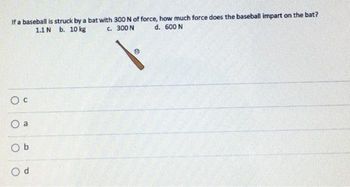Question

Transcribed Image Text:If a baseball is struck by a bat with 300 N of force, how much force does the baseball impart on the bat?
C. 300 N
d. 600 N
1.1 N b. 10 kg
O C
O a
Ob
Od
Expert Solution
This question has been solved!
Explore an expertly crafted, step-by-step solution for a thorough understanding of key concepts.
Step by stepSolved in 3 steps

Knowledge Booster
Similar questions
- Alice has a mass of 62.0 kg and Bob has a mass of 84.0 kg and they are initially standing at rest with respect to one another on a frictionless surface. They push against each other such that Alice moves at 0.04 m/s relative to her starting point. With what speed does Bob move away from his initial position? a. 0.03 m/s b. 0.09 m/s c. 1.21 m/s d. 32.2 m/s e. 1.6 m/sarrow_forwardA 1000 kg car was travelling at 45m/s when it hit a concrete wall due to drunk driving. Find the average force of impact if the car was put to a complete stop after 0.5 seconds. * A. 70 000 N B. 95 000 N C. 85 000 N D. 90 000 N E. 80 000 Narrow_forwardAn 50kg volleyball player lands from a jump and tries to stop her forward motion. The normal contact force exerted by the floor on her shoes is 2000N. The friction force exerted by the floor on her shoes is 600N acting backward on the player. What is the resultant ground reaction force exerted by the floor on the volleyball player’s shoes? s. 2088N b. 50kg c. 491N d. 2600Narrow_forward
- QUESTION 6 A 4.0-kg block has an initial velocity of 10 m/s on a level floor. Because of kinetic friction between the block and the floor, it takes 2.0 s for the block to come to rest. What is the coefficient of kinetic friction between the block and the floor? a. 0.38 Ob.0.64 C. 0.25 Od. 0.77 O e. 0.51arrow_forwardDuring an autumn storm, a 0.012 kg hail stone travelling at 20.0 m/s made a 0.20 cm deep dent in the hood of Casey’s new car. What average force did the car exert to stop the damaging hail stone? *Use g=9.8 a. 240 N b. 86 N c. 120 N d. 48 N e. 521 Narrow_forward10. Ā = -2â + -3ŷ and B = -4â + -4ŷ. Calculate R = Ã+B. Calculate 0, the direction of R. Recall that 0 is defined as the angle with respect to the +x-axis. A. 49.4° B. 130.6° C. 229.4° D. 310.6°arrow_forward
- You find yourself stranded on the middle of a frozen pond. The surface is so slick you are unable to get any traction. In an effort to save yourself, you take off your boot and throw it toward the west. This results in... A. you staying put. B. you sliding off to the east slower than the boot's speed. C. you sliding off to the east faster than the boot's speed. D. you sliding off to the west faster than the boot's speed. E. you sliding off to the west slower than the boot's speed.arrow_forwardA high jumper with a body weight of 900N exerts an average vertical force of 2150N down on the floor for 0.50 s. The average vertical force exerted on the jumper by the floor is: a. 2150N b.1640N c. 900N d.3050Narrow_forward4. The parking brake fails on a parked car at the top of a hill and it rolls down the hill ¹. At that same moment an SUV is coming down a cross street at the bottom of the hill, moving at 30 miles per hour. (See diagram below.) The mass of the car is 1000 kg. The mass of the SUV is 3000 kg. a) Find the speed of the car when it reaches the bottom of the hill. b) The car and SUV collide and move off together. Find their velocity immediately after the collision. ¹ Note that the wheels of a car are so much lighter than the car itself that their rotation is negligible. In short, a rolling car acts like a sliding object, not like a rolling object. W. View from Above N E Hill Side View of the Hill 10m 40°arrow_forward
- A 0.50 kg block slides across a tabletop with an initial velocity of 20 cm/s and comes to rest in a distance of 70cm. Find the average friction force that retarded its motion A. 0.241 N B. 0.014 N C. 0.014 J D. 0.214 Jarrow_forwardA 4.0 kg mass moving at 2 m/s and a 2 kg mass moving at 4 m/s are gliding over a frictionless surface. Both objects encounter the same horizontal force, which directly opposed their motion and are brought to rest. Which statement correctly describes the situation? a. The 2.0 kg mass travels twice as far as the 4.0 kg mass before stopping. b. The 2.0 kg mass travels farther but necessarily twice as far. c. The 4.0 kg mass travels twice as far as the 2.0 kg mass before stopping. d. The 4.0 kg mass loses more kinetic energy than the 2.0 kg mass. e. Both masses travel the same distance before stopping.arrow_forward
arrow_back_ios
arrow_forward_ios